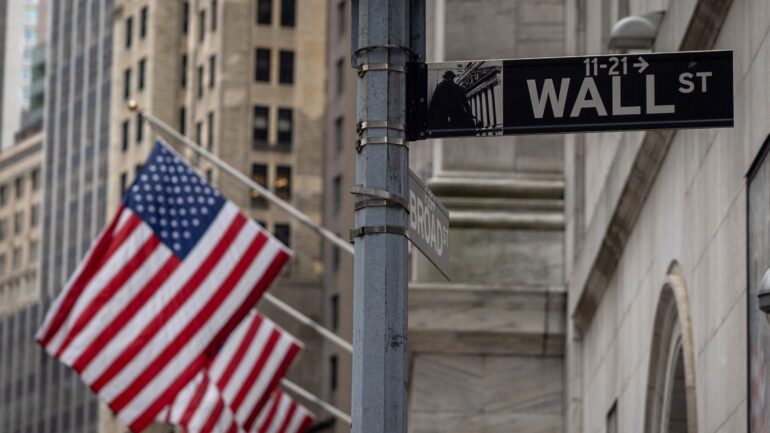TL;DR:
- Wall Street faces a growing concern as real-world borrowing costs surge amidst Federal Reserve hawkishness.
- Fed Chair Jerome Powell emphasizes the need for elevated interest rates adjusted for inflation.
- The tech-driven US equity market, which had seen significant gains, now grapples with skepticism as capital costs rise.
- High real rates tighten financial conditions, impacting tech stocks and making assets like cryptocurrencies less attractive.
- The Nasdaq 100 index experienced a significant decline, trading at high valuations despite the sell-off.
- Uncertainty looms as Powell’s focus on higher real yields challenges expectations of no further rate hikes.
- Despite risk premiums holding steady in credit markets, experts caution that elevated funding costs may impact companies and consumers.
Main AI News:
For investors navigating the tumultuous waters of the stock market this year, the allure of AI’s trillion-dollar promise has served as a beacon of hope, overshadowing a looming threat in the era of Federal Reserve hawkishness: surging real-world borrowing costs across Corporate America. Now, Wall Street finds itself in a state of apprehension, as Jerome Powell reaffirms his commitment to maintaining a tight policy stance, triggering a widespread sell-off affecting not only Big Tech but also the broader market.
Powell’s chosen weapon in his battle to cool down the still-sizzling US economy is ensuring that interest rates, adjusted for inflation and regarded as the true cost of money for borrowers, remain elevated. The Fed chief emphasized the need for real yields to stay substantially positive “for some time” during the recent policy gathering, as these yields reached decade-highs earlier this week.
This chilling message resonates deeply with the top-heavy US equity market. The double-digit gains witnessed this year were predicated on the optimism surrounding nascent technologies like artificial intelligence, which were expected to unlock a new wave of growth for technology companies, justifying their sky-high valuations. However, as the cost of capital escalates, skepticism sets in, casting a shadow over companies, both large and small.
Que Nguyen, Chief Investment Officer of Equity Strategies at Research Affiliates, aptly remarks, “A higher cost of capital is detrimental to equity valuations.” He acknowledges that big tech companies possess unique attributes, such as low leverage, substantial cash flows, and wide economic moats, which can justify higher-than-average valuations. Nevertheless, there is a point beyond which absolute and relative valuations can’t be stretched further, and that point may be approaching for several tech giants.
The prospect of higher interest rates has sent shockwaves across various asset classes. Homebuilders witnessed their seventh decline in eight weeks as a group, while a basket of unprofitable technology firms tumbled, evoking memories of the market turmoil from March. The benchmark 10-year real rates surged to an intraday high of 2.12% on Thursday, marking their highest level since 2009.
Ian Lyngen of BMO Capital Markets cautions that Powell, in his role as a champion for the US economy, maybe overplaying the optimism, leaving risk assets susceptible to the fallout from higher real yields.
Sustainably high real rates serve to tighten financial conditions, a goal frequently articulated by the Fed Chair. As funding costs rise, the cost of doing business increases, putting pressure on tech stocks because their long-term earnings prospects must now be discounted at higher rates. Simultaneously, assets lacking income streams, such as cryptocurrencies, appear less appealing due to the opportunity costs associated with holding them compared to Treasury bonds that offer real returns.
The tech-heavy Nasdaq 100 has already declined more than 5% in September, setting a course for its second consecutive monthly loss and the worst showing of 2023. Even amidst the sell-off, the index still trades at over 31 times annual earnings – lower than the peak of 2021 but higher than most points in the past decade.
While UBS Group AG and others anticipate no further rate hikes from the central bank this year, Powell’s emphasis on the necessity of higher real yields introduces an element of uncertainty into this optimistic outlook.
“The FOMC clearly sees higher real rates as needed to restore price stability,” UBS economists note. “The FOMC signaling their intentions for a higher real rate, more restrictive for longer, than we previously assumed, suggests the risks to our rate call clearly skew upward.“
Interestingly, the credit cycle remains strangely resilient, with risk premiums holding steady across investment-grade and high-yield bonds. Nonetheless, according to Torsten Slok, Chief Economist at Apollo Global Management Inc., the rallies witnessed across risky assets this year may not be sustainable. He advises that funding costs are poised to remain elevated, urging investors across asset classes to prepare for potential challenges.
“We’re going to see the cost of capital bite harder and harder on companies every single day,” Slok warns. “We begin to run the risk, of course, that we’re going to see more companies defaulting and on the consumer side, more people falling behind on their payments.”
Conclusion:
The surge in real-world interest rates, driven by the Federal Reserve’s tightening policy, is casting a shadow over the tech-centric US equity market. While tech giants have shown resilience, the impact of rising capital costs could pose challenges for companies and consumers alike. Uncertainty regarding the Fed’s rate trajectory adds to the complexity of the market landscape, requiring investors to remain vigilant and adaptable in the face of changing economic dynamics.

